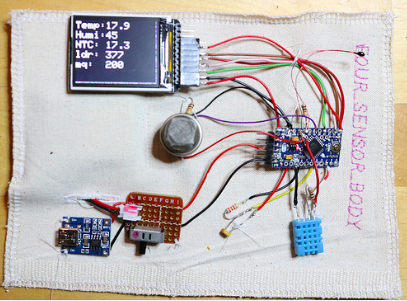SpecialBoards
Normal boards
I have worked a lot with AVR boards, Arduino, or setups with ATmega328, also ATtiny85. Sometimes with RF12, for wireless transmission. With sensor boards attached. Sometimes this board plus sensors is too fragile or to big, or just clumsy. There are now boards with sensors built in. This saves space and makes the board more portable. For education there is the BBC Microbit board, having all kinds of expressions and input without any wires. Of course these boards are not better or so than the Arduino. These boards give other possibilites.
Example of a swatch, different sensors attached to a Arduino Pro Mini (looks quite nerdy!)
A wave of specialized micro controller boards
For a project with interactive kites: https://airlaboart.wordpress.com, I bought and investigated a lot of boards with special characteristics.
All the different categories below require quite a bit of time to get used to and to get it working.
Sometimes you have to write in another programing language, like Micropython
Sometimes you have to install a new tool chain, using the terminal window.
A few links showing this tool chain pain:
https://airlaboart.wordpress.com/2019/07/04/further-intelligence/
https://airlaboart.wordpress.com/2019/07/07/and-the-third-toolchain-maix-dock/
After this project I investigated also the
BBC Microbit (22,95) https://www.floris.cc/shop/en/home/1848-microbit-go-bundel-microbit.html
Adafruit circuit playground express (29,95) https://www.adafruit.com/product/3333
SD cards included
For fast real time data collection. The data are stored on the SD card and can later be retrieved and analyzed, for instance using Processing.
Boards with SD-card:
- Sparkfun Razor
IMU sensors incorporated – https://learn.sparkfun.com/tutorials/9dof-razor-imu-m0-hookup-guide/all#libraries-and-example-firmware
- Adafruit feather M0 adalogger (22,93 euro) https://learn.adafruit.com/adafruit-feather-m0-adalogger/
- Teensy 3.6 https://www.pjrc.com/store/teensy36.html
If the SD card is not on the board you can use this device:
Acceleration included
A lot of boards have acceleration sensors included.
These sensors are referred to as IMU
- BBC Microbit (22,95) https://www.floris.cc/shop/en/home/1848-microbit-go-bundel-microbit.html
- Sparkfun Razor https://www.sparkfun.com/products/14001
- Adafruit circuit playground express (29,95) https://www.adafruit.com/product/3333
These sensors come into a few variaties.
- 3 axes, acceleration x,y,z
- 6 axes, acceleration x,y,z, gyro x,y,z
- 9 axes, acceleration x,y,z, gyro x,y,z, compass x,y,z
Only...no position!
You could think that integrating the acceleration would make it possible to keep track of the sensor and calculate the position after a certain time. The formulas from physics suggest this: just integrating over time. The problem is that the errors are building up.
Gimbal lock - Quaternions
Even more problems: you really need the coordinates to be in so called quaternions and not Euler angles to get a nice graph.
About Quaternions: https://www.3dgep.com/understanding-quaternions/ (This is more theoretical about the math)
Practical, about the sensor data of acceleration, gyro and compass contributing to the quaternions: http://www.camelsoftware.com/2016/02/20/imu-maths/
The Sparkfun Razor software has this quaternions possibility built in.
Camera included
The bigger boards now have cameras included:
- OpenMV7 (75 euro) https://www.antratek.nl/openmv-h7-camera, https://openmv.io
The OpenMV system has an IDE and in this IDE, there is face recognition (sort of).
- Maix Dock one (30,95) https://www.antratek.nl/sipeed-m1w-ai-dev-board-with-lcd-and-camera
AI included
Speech recognition:
- Sparkfun Edge (18,09) https://www.antratek.nl/edge-development-board-apollo3-blue
Gesture recognition:
- Intel Curie Tiny Tile https://software.intel.com/en-us/node/675623
The camera boards have some face recognition possibilities, that is they recognize a face - not a person...
Slow and Fast Sensors
Some data have to be tracked fast, like acceleration, gyro, compass, others can be sampled at a lower rate, like temperature, pollution, air pressure.
This means that different sets of sensors can be grouped together.
BLE included
The BBC Microbit has BLE and the microbit can communicate amongst themselves quite easily.
(I saw that the Adafruit circuit Express now also has BLE).
Summery of the boards
- Teensy 3.6, https://www.pjrc.com/teensy/pinout.html
manual: https://www.pjrc.com/teensy/K66P144M180SF5RMV2.pdf
SD card: https://forum.pjrc.com/threads/55114-SD-Datalogging-Best-Practice-in-2019
IMU library: NXPMotionSense
- Intel Curie Tiny Tile: https://software.intel.com/en-us/node/675623
- Adafruit circuit playground express (29,95) https://www.adafruit.com/product/3333
IMU
- Adafruit feather M0 adalogger (22,93 euro) https://learn.adafruit.com/adafruit-feather-m0-adalogger/
SD card
- Maix Dock one (30,95) https://www.antratek.nl/sipeed-m1w-ai-dev-board-with-lcd-and-camera
AI
- BBC Microbit (22,95) https://www.floris.cc/shop/en/home/1848-microbit-go-bundel-microbit.html
IMU
- OpenMV7 (75 euro) https://www.antratek.nl/openmv-h7-camera, https://openmv.io
Camera
- Sparkfun Edge (18,09) https://www.antratek.nl/edge-development-board-apollo3-blue
AI, sound

